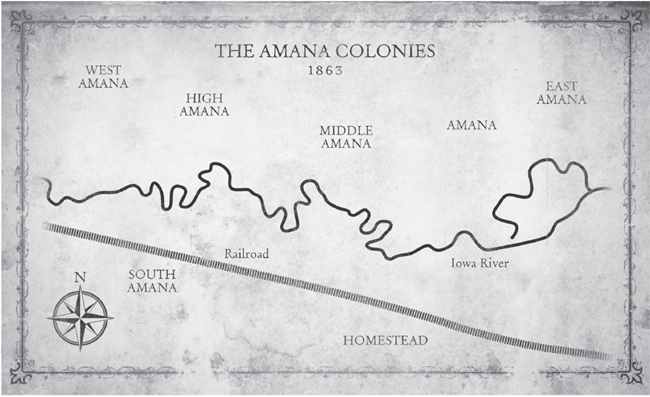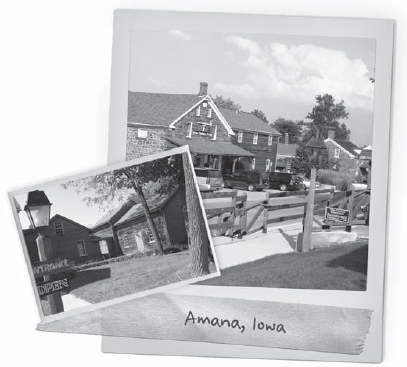Love Finds You in Amana Iowa
Read Love Finds You in Amana Iowa Online
Authors: Melanie Dobson
Tags: #Love Finds You in Amana Iowa




BY MELANIE DOBSON

Summerside Press™
Minneapolis 55438
www.summersidepress.com
Love Finds You in Amana, Iowa
© 2011 by Melanie Dobson
ISBN 978-1-60936-135-8
All rights reserved. No part of this publication may be reproduced in any form, except for brief quotations in printed reviews, without written permission of the publisher.
A Scripture references, unless otherwise indicated, are from the Holy Bible, King James Version (
KJV
). Scripture references marked niv are from The Holy Bible, New International Version
®
,
NIV
®
. Copyright © 1973, 1978, 1984 by Biblica, Inc.™ Used by permission of Zondervan. All rights reserved worldwide.
The town depicted in this book is a real place, but all characters are fictional. Any resemblances to actual people or events are purely coincidental.
All epigraphs used with permission from the Amana Church Society. Translated from the German Psalter-Spiel (Amana Church Hymnal).
Cover Design by Koechel Peterson & Associates |
www.kpadesign.com
Interior design by Müllerhaus Publishing Group |
www.mullerhaus.net
Map of the Amana Colonies by Kristin Chambers, PaperWasp Studio |
paperwaspinvites.com
Back cover and interior photos of Amana, Iowa, provided by Melanie Dobson.
Summerside Press
™
is an inspirational publisher offering fresh, irresistible books to uplift the heart and engage the mind.
Printed in USA.
Dedicated to my daughter Kinzel Shae

Your love and sweet laughter fill my heart with joy.
You are my treasure.


T
UCKED INTO
I
OWA
’
S BEAUTIFUL ROLLING HILLS IS A CLUSTER OF SEVEN
quaint villages called the Amana Colonies. The settlement was birthed in 1855 when thirty-three Inspirationists arrived from Ebenezer, New York, to build the main village of Amana. By the end of 1864, there were more than twelve hundred people living in this new colony.
The Amana people share a profound spiritual heritage, and for eighty years, they worked and lived in a communal system. The Amana Society provided food, housing, medical care, and schooling for every member until the members voted to dissolve the commune in 1932.
While the Amana Colonies are no longer a commune, many of the people living in Amana still worship and work together. Grapevines adorn the brick and stone homes today, and the aromas from the bountiful gardens and bakeries waft through the streets. The Iowa River weaves through the villages along with a peaceful canal that once powered the textile, grain, and saw mills.
Charming inns and good German food abound in these colonies, and visitors can spend days touring craft shops, art galleries, museums, wineries, quilt stores, and an original communal kitchen. With the exception of the trains that whistle their way through the colonies, the nights are calm, and when the clouds are gone, thousands of stars illuminate the dark sky.
Welcome to a quieter place, a retreat from the frenzied world outside.
Willkommen
to the Amana Colonies.
Melanie Dobson
The road to good is often wild
With briars and with thorns defiled.
Paul Gerhardt

July 1863
Wagon wheels rumbled over the hard earth and stones along the Ohio trail before dipping down to splash through a creek. Rain clouds swathed the hot sky, pacifying the intense sunrays for seconds and sometimes minutes at a time. Nature’s game of hide-and-seek was welcome relief from the heat that had trailed the Inspirationists since they left New York. Two long weeks ago.
Water seeped through Amalie Wiese’s boots as she stepped into the creek. The coldness bathed her stockings and chilled her toes. If only she could take a bath tonight. Clean the dust and sweat off her skin and soothe the aches that rippled up her legs and back and settled into her shoulders.
Beside her Karoline Baumer picked up her skirt and stepped into the creek. She squealed with delight as the cold water soaked her bare toes and splashed on her legs. Her friend’s pale yellow hair was hidden under a lilac-colored sunbonnet, the same sunbonnet all of the women in their community wore. Even with the head covering draped over her ears and shoulders, hiding her cheeks, Amalie could see the freckles that dotted the nose of the lively girl who’d been working beside her for the past two years.
Karoline was barely twenty, but she was one of the hardest workers Amalie knew. And there was nothing Amalie respected more than a man or a woman who worked hard.
For the past ten of her twenty-four years, Amalie had cooked and cleaned six and a half days a week as a helper and then as the assistant
baas
in one of the colony’s communal kitchens. She didn’t mind the cooking or cleaning. It was the wilderness she hated. The dirt and the bramble and the vicious mosquitoes that liked to feed on her skin. Her kitchen was clean. Controlled. With a bit of scrubbing, she could eradicate any sign of disorder in the kitchen, but out here on the trail, there was no way to keep the dirt off her clothes, her skin, or her dishes.
She wouldn’t grumble about the long journey through the trees and hills, at least not with her lips, but it comforted her to know that the elders would never ask any of them to travel the states between New York and Iowa again. Once they reached the new
Kolonie,
they would be home.
“How are your feet?” Karoline asked.
“Blistered.”
Karoline actually giggled. “Mine too.”
“I wish I could laugh about it.”
“You should take off your shoes,” Karoline said, but Amalie shook her head. Even if she could hide her bare feet under her long dress, she didn’t want her toes to touch the dirt.
“It’s all part of the adventure,” Karoline insisted.
“I’m having enough of an adventure with my shoes on.”
Copper boilers, kettles, and skillets clanged in the wagon beside the women, and behind them was another wagon filled with barrels of flour and sugar, flatware, tablecloths, and ceramic jars to start the new Kolonie kitchen. The barrels and crates rattled together as they forged the creek.